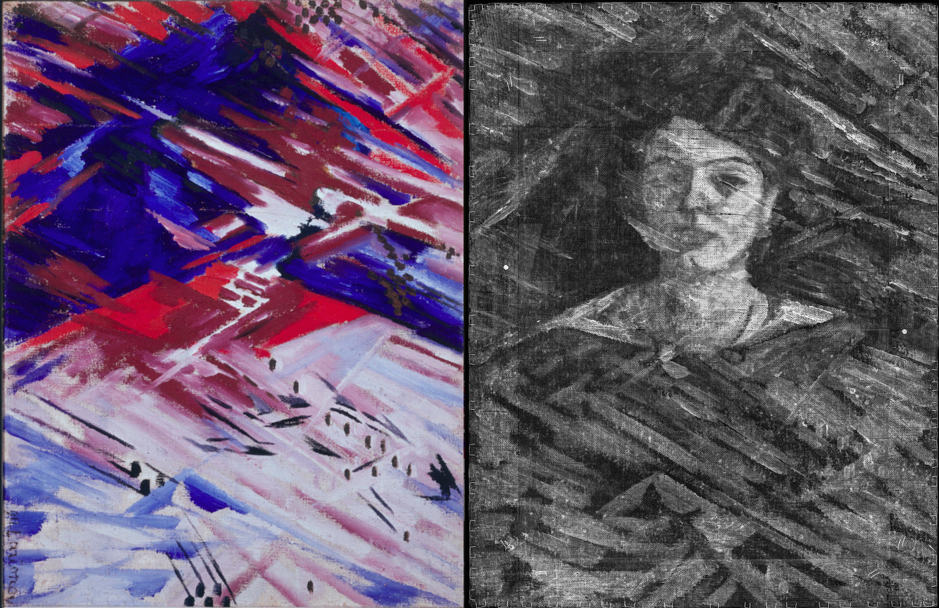Beneath the Surface - the Power of Infrared Imaging
09 September 2022
ShareDiscovering secrets beneath the surface of a painting can dramatically alter its value.
Billy Jobling
Billy Jobling is Senior Writer and Researcher in the Post-War and Contemporary Art department at Christie's, London.
Examining a painting can be rather like visiting the scene of a crime. What material clues have been left that might tell us how—or when—the work was made? Can we retrace the movements of the artist’s hand, or see someone trying to cover their tracks?Often, the answers lie beneath the surface. Short of physical micro-sampling, infrared imaging offers insightful information that uncovers many hidden clues.
A form of energy beyond the visible light spectrum, infrared radiation (IR) passes through some pigments, but not others: crucially, it is absorbed by the dark materials painters have historically used for underdrawing, such as charcoal and graphite. Used correctly, infrared reflectography (IRR) captures an image that effectively renders the paint layer transparent, revealing potentially critical evidence below.
Museum discoveries made using this technology, such as the startling spectre of a man behind Picasso’s Woman Ironing (1904), have made headlines for their art-historical importance. As well as institutions, however, the advantages of IRR are available today to private collectors, auction houses and insurers through leading analysis firms like ArtDiscovery.

Left, Red and Blue Rayonism (Beach) by Mikhail Larionov. Right, X-ray image of the painting.
Credit: ArtDiscovery
‘We use it both alone and in combination with other techniques to answer questions around the condition, the process of development, and the authenticity of works of art’, explains the company’s UK director, Dr Jilleen Nadolny. ‘It has been used to reveal aspects of an artist’s creative processes, underdrawings, alterations and reworkings (sometimes revealing overpainted or faded signatures, text or drawings) and restorations. Infrared examination can also be used to differentiate between certain groups of pigments and inks.
IRR methods have come a long way since the Vidicon cameras developed in the 1960s, which required multiple small images to be mosaiced together. ArtDiscovery’s scanning technology is fine-tuned to each artwork, using cameras with different capabilities to record high-resolution images across a range of wavelengths.
What is uncovered can be transformative. One client’s painting, Dr Nadolny tells me, had been attributed to a follower of Bellini, and was marred by some later restoration. ‘However, on the basis of the quality of the underdrawing revealed through the IR, the client was able to present the work to a Bellini expert, who reattributed the work to the master himself, increasing tremendously the market value of the object.’
A variation on the reflective technique, known as ‘transmitted IR’, captures IR energy that has passed X-ray-like through an object, exposing even more deeply hidden information. ‘Using transmitted IR on a work that was undergoing research as a possible Titian, we revealed the stamp of King Charles I, “CR”, on the back of the painting, which had been covered for centuries by a lining canvas. The discovery, which helped to confirm the provenance of the piece, allowed the work to realise its full value.’
ArtDiscovery also employ IRR scans in combination with X-rays, their cousins from lower down the electromagnetic spectrum. One such instance found a painting hidden beneath a newly discovered work by Kandinsky; the concealed composition was matched to a known sketch by the artist, bolstering the attribution.
‘A similar case was a painting deemed to be “after John Constable” that we analysed through technical imaging, unveiling features that helped experts confirming its attribution to Constable himself’, says Dr Nadolny. ‘The artwork, purchased for $5,000, is now estimated to value around $5 million.’
Such dazzling revelations, beyond the reach of the human eye, have sometimes led to the view that the authenticating role of the ‘connoisseur’ might one day be rendered obsolete by cold, hard science. ArtDiscovery, whose team are both technical art historians and trained conservators, see the disciplines as complementary.
Carbon-14 dating, for example, can allow connoisseurs to form an opinion according to solid evidence of an object’s age. Equally, scientific work can help to quantify the subtle hallmarks of a specific artist’s technique. Having seen dozens of both real and ersatz Modiglianis, ArtDiscovery has been able to build a detailed dataset on the artist’s idiosyncratic brushwork, which has become a valuable resource for the scholars currently revising his catalogue raisonné. Working together, scientists and connoisseurs are able to pool their expertise to draw conclusions with the greatest degree of certainty—and that certainty has enormous value.
As the field of art analysis evolves, new techniques such as sound and laser imaging and elemental mapping promise to reveal new depths of information, though it may be some time before these technologies become viable for regular commercial use. ‘As objects are complex structures, there are many variables when considering the challenges of authentication and attribution’, explains Dr Nadolny. ‘We try to offer the best options to our clients in a manner that works with their objectives.’ For now, infrared imaging remains a vital tool in ArtDiscovery’s interdisciplinary work and is sure to uncover many more exciting secrets yet.

